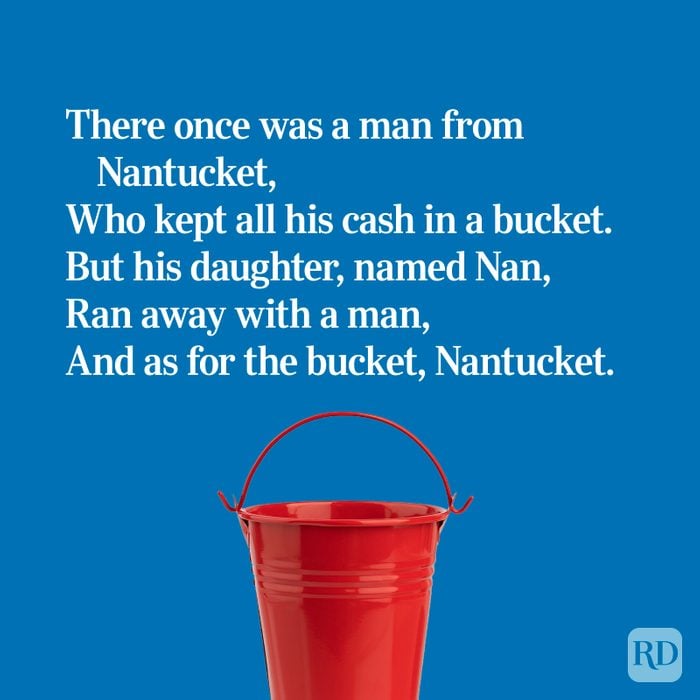12 Famous Limerick Poems and Examples to Spark Your Creativity
Updated: Jul. 11, 2024

What are limerick poems? These are some of the best limerick examples to find out.
The word poetry typically sparks thoughts of love poems and doesn’t necessarily bring fun and laughter to mind. The exception to the rule? Limerick poems, a form of humorous poetry that’s been making us laugh for hundreds of years. Although there are many funny limericks, the exact origins of the form have been lost to time, although they may date back to medieval Ireland and possibly got their name from the Irish city or county of Limerick.
However, limerick poems as we know them today first appeared in the 18th century. They were popularized in England by the writer Edward Lear in his first Book of Nonsense, published in 1846. In total, Lear wrote and published 212 limericks, and he is still one of the best-known writers of limericks, even now. Many of his nonsense poems make great limericks for kids, but adults enjoy them too.
But, if you’re curious about limerick poems — maybe even considering how to write your own, we’re sharing some of our favorite limerick examples to help you find out how.
Get Reader’s Digest’s Read Up newsletter for more humor, fun facts, cleaning, travel and tech all week long.
On This Page
What is a limerick, anyway?
Limerick poems follow a strict structure: five lines, in which the first, second and fifth lines are longer and rhyme, while the third and fourth lines are shorter and share a separate rhyme (you may see this rhyme structure referred to as “AABBA”). There is often unusual stress in recitation, with emphasis placed on every other word starting with the second one. The humor usually comes in the final line, with a sudden reversal or twist, wordplay or twisted rhyme. When Lear was writing, the last line was often the same as the first apart from this twist, but this is no longer the popular form.
Common limerick formats
Limerick poems follow repeated patterns. They often open with lines such as, “There once was a (someone) from (somewhere) …” or “There was a (someone) who (something) …” One of the most famous opening lines is: “There once was a man from Nantucket …” That limerick was written by a Princeton professor and appeared in the college’s humorous newspaper, the Princeton Tiger, in 1902. Here it is in its entirety:
There once was a man from Nantucket,
Who kept all his cash in a bucket.
But his daughter, named Nan,
Ran away with a man,
And as for the bucket, Nantucket.
Frequently, limerick examples with this opening line are extremely vulgar, to the point that “There once was a man from Nantucket” has become a kind of cultural shorthand. However, there are many other limerick examples with a similar format without that sort of subtext.
How to write a limerick poem
Interested in putting pen to paper and creating your own limerick? Follow these steps.
Step 1: Pick a theme for your limerick poem, and make sure it will help you tell a funny story.
Step 2: Remember to follow the AABBA structure, meaning you’ll need five lines of copy.
Step 3: Keep the syllable patterns in mind when writing. For limericks, the first, second and fifth lines typically have eight or nine syllables; lines three and four typically have five or six syllables.
Step 4: Pick an opening line that will help you set up a story, and make sure the last word rhymes with other words. If you’re stuck, you can start with the classic “There once was a man from Nantucket” line and go from there.
Step 5: Give that last line a twist!
If you still need some help writing limerick poems, don’t fret—we have some famous limerick examples below for inspiration.
Limerick poem examples
1. “There was an Old Man with a Beard”

Lovers of short poems can appreciate limericks for their imaginativeness and silliness. And this limerick poem by Lear doesn’t hesitate to make us giggle.
There was an Old Man with a beard,
Who said, “It is just as I feared!—
Two Owls and a Hen,
Four Larks and a Wren,
Have all built their nests in my beard!”
2. “There was a Young Lady Whose Chin”

You’ll find this limerick poem in Lear’s limerick collection, “A Book of Nonsense,” which is full of famous poems you should read at least once.
There was a Young Lady whose chin,
Resembled the point of a pin:
So she had it made sharp,
And purchased a harp,
And played several tunes with her chin.
3. “There was an Old Man of Thermopylæ”
Here’s a fun fact about Learian limericks: They zoom in on one intriguing individual, whether they’re old or young, a “Person,” “Man,” or “Lady.” In this case, we have another “Old Man.”
There was an old man of Thermopylæ,Who never did anything properly;But they said, “If you choose, To boil eggs in your shoes,You shall never remain in Thermopylæ.”
4. “There was an Old Man on the Border”

Along with his knack for writing limericks, Lear was also a talented drawer and painter. Despite having little formal education, he was commissioned by Edward Stanley, later the 13th earl of Derby, to draw the animals in his farm at Knowsley, the Derby estate in Lancashire.
There was an old man on the Border,Who lived in the utmost disorder;He danced with the cat, and made tea in his hat,
Which vexed all the folks on the Border.
5. “There was an Old Person of Nice”

There was an old person of Nice,Whose associates were usually Geese.They walked out together, in all sorts of weather.
That affable person of Nice!
6. “There was an Old Lady of France”
There was an old lady of France,
Who taught little ducklings to dance;
When she said, “Tick-a-tack!”
They only said, “Quack!”
Which grieved that old lady of France.
7. “There was a Small Boy of Quebec”

The writer Rudyard Kipling, famous for works such as The Jungle Book, penned this tale of a young French-Canadian boy:
There was a small boy of Quebec,
Who was buried in snow to his neck;
When they said, “Are you friz?”
He replied, “Yes, I is—
But we don’t call this cold in Quebec.”
8. “There Was an Old Man of Quebec”

Here’s another limerick example by the famed Lear (and oddly enough, this one is also set in Quebec):
There was an Old Man of Quebec,
A beetle ran over his neck.
But he cried, “With a needle,
I’ll slay you, O beetle!”
That angry Old Man of Quebec.
9. “There was a Young Lady of Ryde”
Lear also wrote limericks set closer to home, like this one about Ryde, on the Isle of Wight in the U.K.:
There was a Young Lady of Ryde,
Whose shoe-strings were seldom untied.
She purchased some clogs,
And some small spotted dogs,
And frequently walked about Ryde.
10. “A Dozen, a Gross and a Score”

British mathematician Leigh Mercer, who was a master of both wordplay and numbers, crafted this famous limerick poem as an equation. We’ve spared you the math, but here’s the limerick example:
A dozen, a gross and a score,
Plus three times the square root of four.
Divided by seven,
Plus five times eleven,
Is nine squared and not a bit more.
11. “There was a Professor Named Chesterton”

For Gilbert and Sullivan fans, this one is by W.S. Gilbert himself, with the British past-tense pronunciation of ate—”et.”
There was a professor named Chesterton,
Who went for a walk with his best shirt on.
Being hungry, he et it,
But lived to regret it,
And ruined for life his digestion.
12. “A Man Hired by John Smith Co.”
Here’s a limerick poem by the incomparable Mark Twain. With Twain being the prankster that he was, this one requires a bit of head-scratching. You have to read the abbreviation (i.e., Co. = company), then add that ending to each abbreviation. So it becomes: “Company,” “thump any” and “dump any.” Extremely tricky! But that’s limericks for you: funny, punny and filled with dubious rhymes.
A man hired by John Smith and Co.,
Loudly declared that he’d tho.
Men that he saw,
Dumping dirt by the door,
The drivers, therefore, didn’t do.
Why trust us
Reader’s Digest has been telling jokes for more than 100 years, curated and reviewed over the last 20 years by Senior Features Editor Andy Simmons, a humor editor formerly of National Lampoon and the author of Now That’s Funny. We’ve earned prestigious ASME awards for our humor—including comical quips, pranks, puns, cartoons, one-liners, knock-knock jokes, riddles, memes, tweets and stories in laugh-out-loud magazine columns such as “Life in These United States,” “All in a Day’s Work,” “Laughter Is the Best Medicine” and “Humor in Uniform,” as well as online collections such as short jokes, dad jokes and bad jokes so bad, they’re great. You can find a century of humor in our 2022 compendium, Reader’s Digest: Laughter, the Best Medicine. Read more about our team, our contributors and our editorial policies.






















